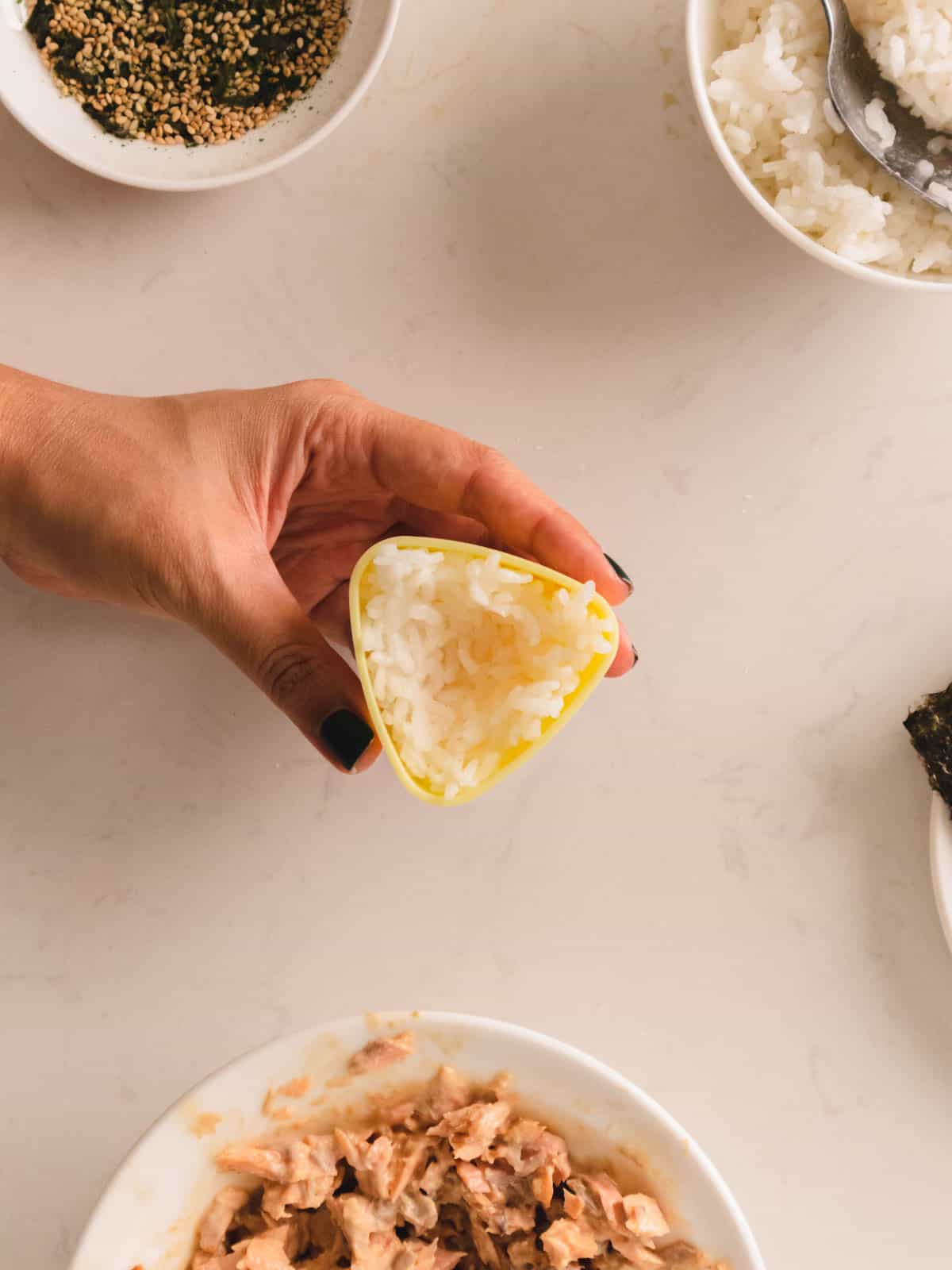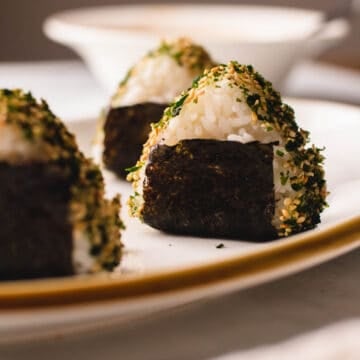Kick soggy sandwiches & boring lunches goodbyyyye! Enjoy these easy Salmon Onigiri on-the-go while transporting your tastebuds to pure happiness – in just 15 minutes!

Simple ingredients come together so easily for this beginner-friendly Salmon Onigiri recipe! Give that lonely leftover salmon new delicious purpose and create a filling snack you can enjoy on the go – no utensils required!
These delicious rice balls are popular at Japanese convenience stores & one of the things I love about them is that it’s SO versatile too. Not feeling salmon? No worries – swap it for Tuna onigiri or even grill it up for even more depth of flavor as Yaki Onigiri!
If you’re feeding a crowd, whip up an easy Sushi Bake for bite-size sushi handrolls in 30 minutes or less – no fancy rolling required. Craving more veggies? Create Sesame Tuna Onigirazu or Spicy Vegetable Onigirazu loaded with crisp vegetables for another version of a full meal in the palm of your hand!
❤️ Highlights
🥘Salmon Onigiri Ingredients

- Cooked Rice: For this Salmon Onigiri recipe, we’re going with sushi rice – a short grain rice that has a nice chew & much stickier than long grain rice. If you use long-grain rice (such as jasmine rice) or brown rice, you’ll find your onigiri easily falling apart because it doesn’t have that same stick consistency. You can grab short-grain rice at your local Asian and Japanese market or online labeled as sushi rice or sweet rice, super easy!
- Salmon: Any cooked salmon is a great way to create a quick meal. So, seared salmon fillet, canned & drained salmon, leftover salmon, or even salmon flakes would all be delicious!
- Japanese Mayo: Alright, let’s talk mayo! Once you try Japanese mayo, there’s no going back! It’s creamy with a subtle tang that makes it next level compared to the regular American mayo in my humble opinion. I HIGHLY recommend using it for this recipe. You can find it at Asian and Japanese markets or even at some local grocery stores in the Asian/International section. It’s SO good, slowly becoming a pantry staple!
- Soy Sauce: Now, for extra umami, I like to season the filling with regular soy sauce (not low sodium). It brings in that salty and umami goodness.
- Sesame Oil: This is a pantry staple that adds a deep nutty flavor. A touch goes a long way & an absolute must!
- Rice Vinegar: Just a touch of rice vinegar goes a long way to balance out the creaminess and saltiness of our other ingredients.
- Sriracha: Spicy lovers, this one is for you! Add a bit (or a lot if your spicy heart desires). This is totally optional! This spicy Salmon Onigiri is all about making them your own, so spice it up to match your taste buds!
- Salt: A sprinkle of salt is used on the rice in Japanese cuisine not only to season it, but it also helps preserve the onigiri. But remember, a little goes a long way, so don’t go overboard. You don’t want your onigiri to be salty!
- Nori: Nori seaweed adds extra flavor and prevents your fingers from getting too sticky from the rice when eating. Some nori sheets come perforated for even easier prep!
- Furikake: Last but not least, let’s talk about furikake. There are a ton loads of varieties, but they all start with seaweed and sesame seeds. Feel free to get creative and use your favorite furikake.
See recipe card for quantities.
📖 Variations & Substitutions
Onigiri is all about making it your own! If you’re a spicy lover, add more even more sriracha – adjust to your tastebuds.
Not in the mood for salmon? Swap it out or mix & match your fillings. Here are a few ideas:
- Tuna onigiri
- Yaki ongiri (grilled ongiri)
- Mentaiko (spicy cod roe)
- Furikake (sprinkled all over onigiri)
- Umeboshi (Japanese pickled plum)
- Okaka (shaved bonito flakes)
- Kambu (seaweed)
- Salted salmon
🔪 How to Make Salmon Onigiri

Step 1: In a medium-sized bowl, make the onigiri filling by combining flaked salmon, Japanese mayo, soy sauce, sesame oil, rice vinegar, & sriracha (if using). Set aside.

Step 2: Dip your onigiri mold in cold water (this makes it easier to remove the salmon rice ball later). Sprinkle a tiny bit of salt at the bottom of the mold, then add a layer of rice with a little divot in the center. Dip your fingers/spoon with some cold water to prevent sticking & make the warm rice easier to work with.

Step 3: Add about a tablespoon of the salmon filling to the middle of the mold, cover the filling with more rice, then sprinkle a tiny bit more salt on top.

Step 4: Place the mold’s lid on top & give it a gentle but firm press. You’ll want to feel just a bit of resistance. If not, add a little more white rice to make sure your onigiri is snug. Gently press the back of the mold to release your onigiri!

Step 5 (optional): Roll the sides of the salmon rice balls in furikake. This is optional for presentation & extra flavor!

Step 6: Wrap in nori strips, then repeat the process for remaining rice & onigiri filling. Enjoy your delicious salmon onigiri immediately!

👩🏽🍳 Key Tips
- Easy Onigiri Making with a Mold: Using a mold is a game-changer when it comes to making onigiri! It saves so much time & comes out perfect every time! Just be sure to really pack that rice and filling into the mold – it’s like giving your onigiri a cozy home that keeps it from falling apart as you enjoy it.
- No mold? No Worries! Wet your hands with water & add a pinch of salt. Spread a thin layer of rice into your palm, add a bit of salmon filling in the center, then wrap the rice around it into a compact triangle shape. Wrap it in some nori & enjoy! It might not be perfect at first but it gets easier with a little practice.
- Rinse that Rice: Before cooking your sushi rice, rinse it thoroughly until the water runs clear. This key step remove excess starch that could turn your rice into a mushy gluey mess.
- Use Warm Rice: Fresh, hot rice is the secret to super-sticky onigiri that easily holds its shape. Cold rice just doesn’t stick as well.
- Keep Rice Off Your Hands: Rice, especially the short-grain kind, can be a super sticky. To make your life easier, dip your hands or spoons in water before getting touchy with the rice. It’ll help keep that stickiness in check.
- The Salt Story: Sprinkle a dash of salt at the bottom of your mold and again on top of the rice. It’s not just for flavor – it also helps preserve your onigiri.

💭 Recipe FAQs
🥗 More Easy Recipes You’ll Love
Let’s get cooking!
Get into my secret stash of Goody-Packed Newsletters with meals planned for you & time-saving tips! Want step-by-step videos of how to make my recipes too? I gotchu over at my youtube channel. Aight, enough chatting, more eating!

Easy Salmon Onigiri (Japanese Salmon Rice Balls)
Ingredients
- 4 oz canned or cooked salmon drained/pat dry and flaked
- 1 ½ tablespoons Japanese mayo
- 1 ½ teaspoon soy sauce
- ½ teaspoon sesame oil
- ⅛ teaspoon rice vinegar
- ¾ teaspoon sriracha optional
- 1 ½ cup freshly cooked short grained rice*
- Salt
- 3 nori sheets cut into 4-inch x 1 ½-inch strips
- Furikake optional for garnish
Instructions
- In a medium-sized bowl, combine salmon, Japanese mayo, soy sauce, rice vinegar, & sriracha (if using). Set aside.
- In the onigiri mold, sprinkle a very small amount of salt, add enough rice to cover the bottom of the mold. Then, add about 1 ½ tablespoon of salmon filling in the center, then more rice on top to cover the filling. Note that the amount of rice and filling depends on the size of the mold. For best results, make sure your rice & filling are really packed in.
- Put the top of the mold on top, then gently & firmly press to make rice tightly packed. You should feel a little resistance, but if you don’t, you might want to add a bit more rice so your onigiri is full & tightly pressed together. Press the back of the mold to release the onigiri.
- Wrap onigiri with a piece of nori.
- Roll the sides of the onigiri in furikake, if using. Repeat for remaining filling & rice. Enjoy immediately!
Notes
- Rice: Short grain rice can be labeled sushi or sweet rice & can be easily found at local Asian or Japanese markets. If you have trouble finding it, medium-grain rice also works, but it won’t be as sticky or have the same chew.
- Salmon: This is a great way to use up any leftover salmon hanging out in the back of the fridge. Drained canned salmon works too.
- Furikake: This is optional for presentation & extra flavor! There are plenty of variations of furikake but the core ingredients include sesame seeds & nori. Feel free to use any of your fave variations!
- Key Tips: For step-by-step photos & key tips on forming the onigiri rice balls, scroll to the blog post above.
Nutrition
Exact calculations may vary. For the most accurate nutritional information, use your preferred nutrition calculator, actual ingredients, and quantities used for the recipe. Please consult with your physician or registered dietitian if more precise nutrition calculations are needed for health reasons.










These turned out so great and flavorful! A quick meal if you have leftover rice 🙂
Yayay! So glad you enjoyed it, Anne! Thanks for sharing 🙂